Nov 1 2016
Tuesday – 60 minutes Steady State and Stroke Metrics
Steady State was on the menu, and in a lighter form, because this is an easy week. On my commute, I read Greg Smith’s blog about his 4×20’/1′ rest plus stroke metrics session, so I tried to show exactly the same stroke metrics plots for my 60 minutes row. I didn’t take exact 1 minute breaks, but rowed a “Just Row” and took small drinking breaks. Also, I had to interrupt my row a few times (esp in the first 10 minutes) to fiddle with the radio. 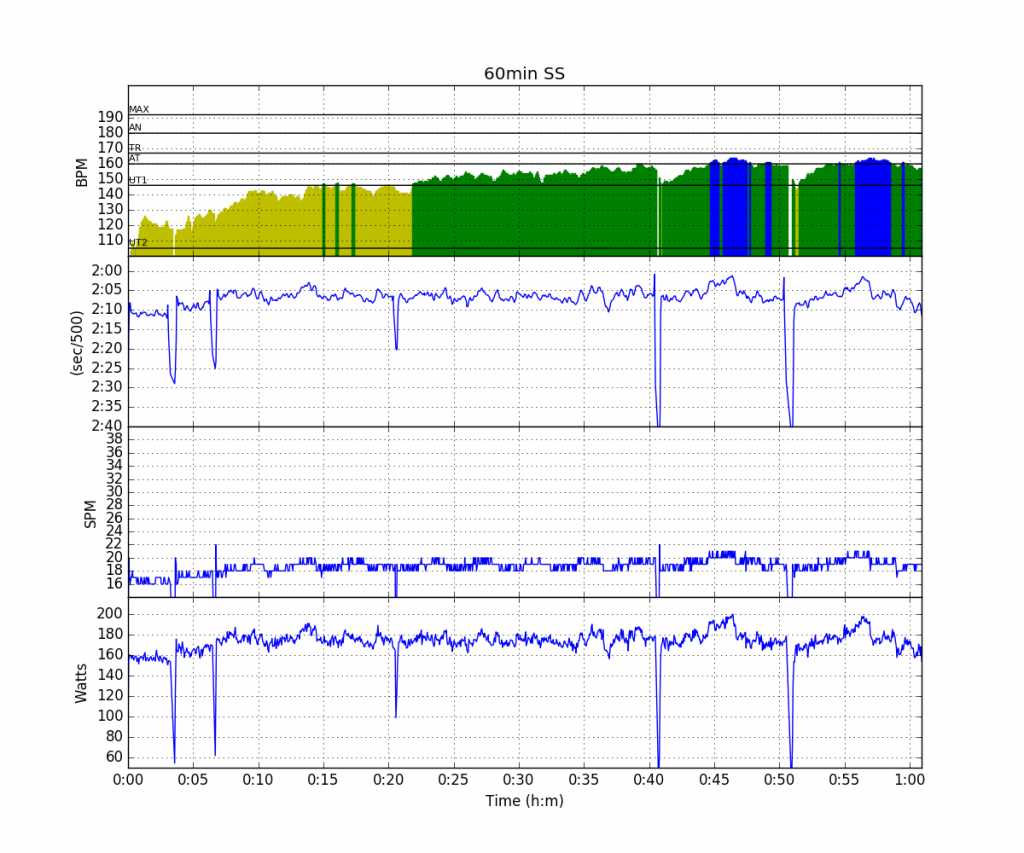
My steady state rowing is not at “10 Watt per SPM”, but roughly 15 Watts below that, so at 18SPM, I row 165-170W, etc.
Power versus stroke rate:
My plot is a bit more fuzzy than Greg’s. I seem to be driven to 19SPM at these power levels. 19SPM is like a magnet, and I lacked the concentration to try and hit the prescribed stroke rates better.
Drive length:
On this parameter, I seem to be more constant and in a narrower band than Greg. Now, a metric where I will be significantly weaker. Peak and Average Force:
Interestingly, my average force is much closer to Greg’s than my peak force. A slightly negative correlation, although not as strong as on Greg’s plot. This may be something to do with drag factor and average flywheel speed as well.
Finally, Work per Stroke:
Again, the plot is strongly influenced by me gravitating towards 19spm. This was also one of my rows where I was hitting a higher Work per Stroke than on average. Here is a plot of my rows for the month October:
Here
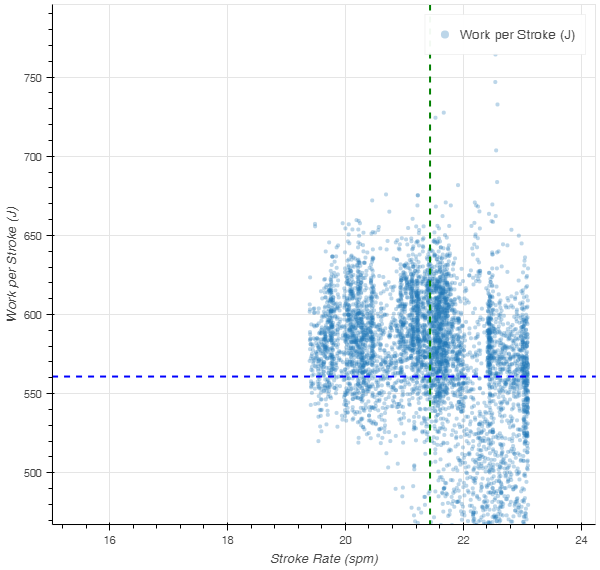
I have capped the data at 23SPM to filter out the hard distance rows. Here is the same plot with today’s data included:
To the left, and upward!
It was fun to do this. As the author of rowsandall.com, I spend more time programming additions to the site than using it for data analysis. And when I do use it for analysis, I can’t help but think of the way the data are flowing through the different pipes and filters:
There are still many good ideas to implement on the site, so the work is not done!

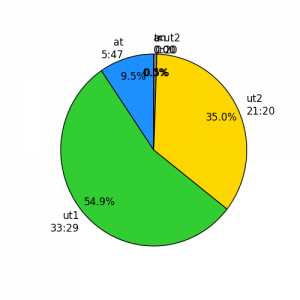
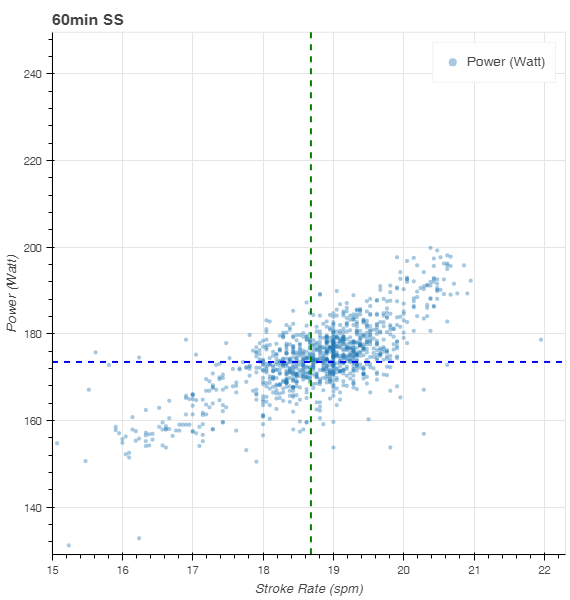
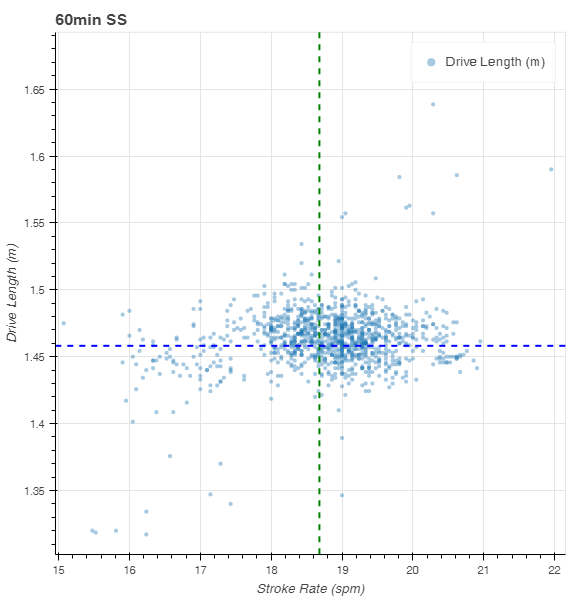
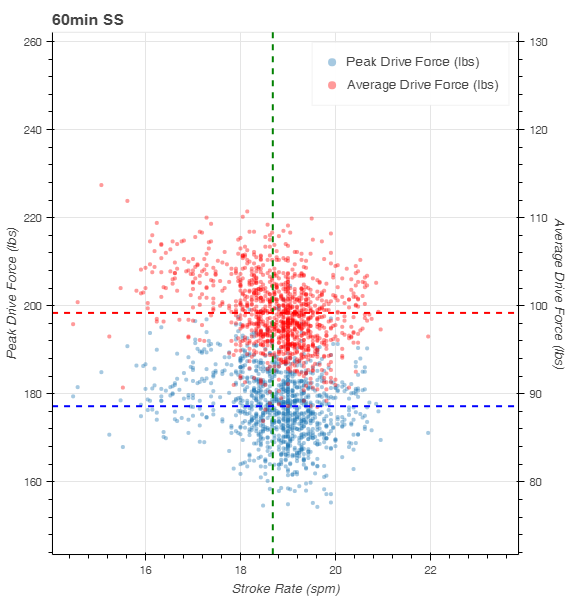
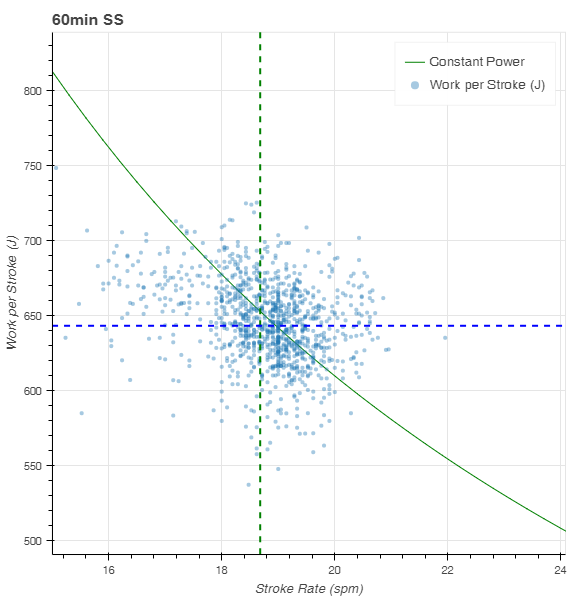
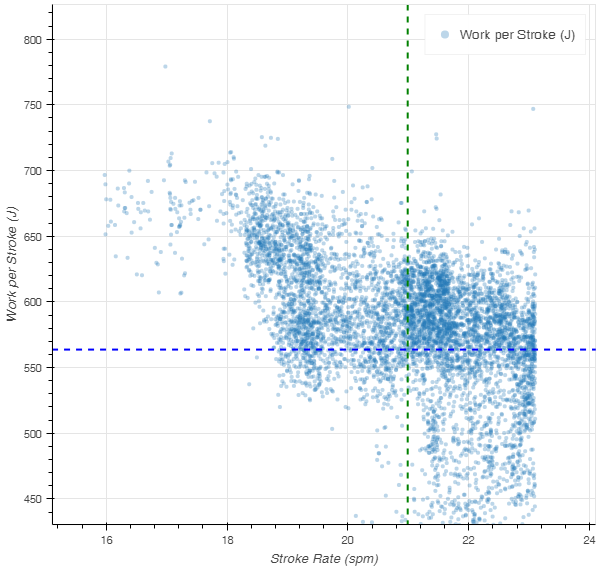

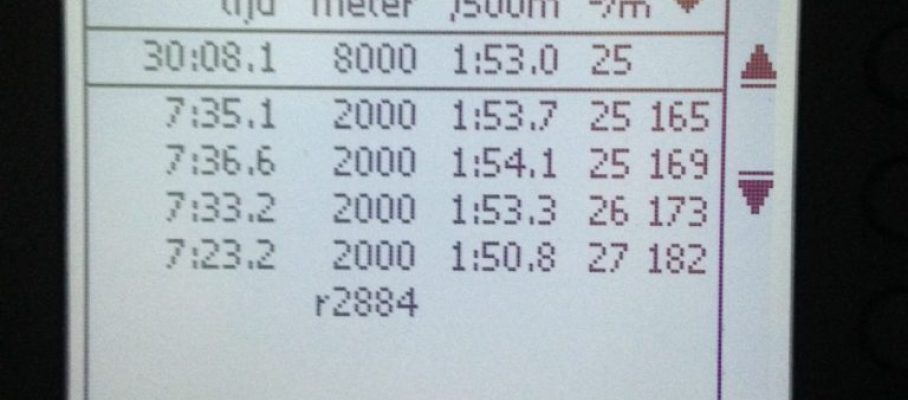
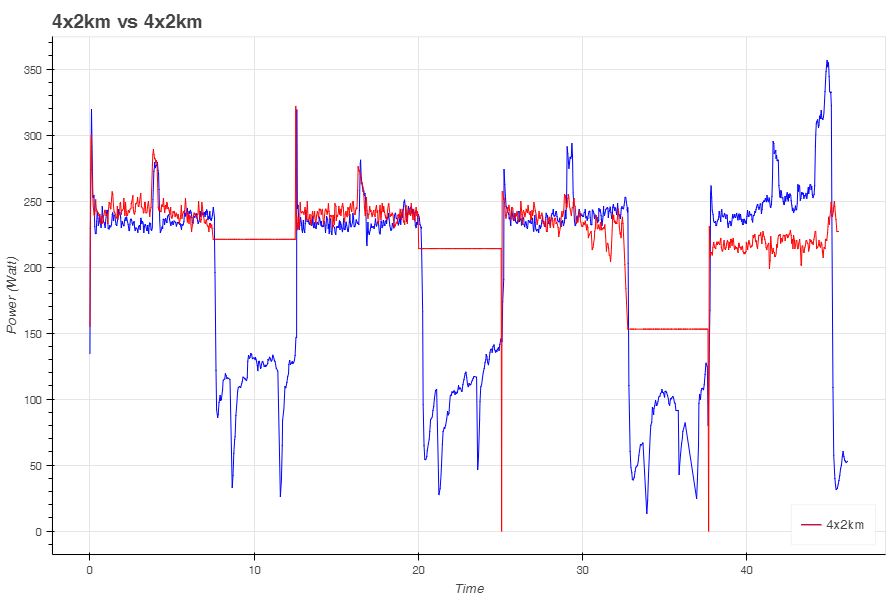
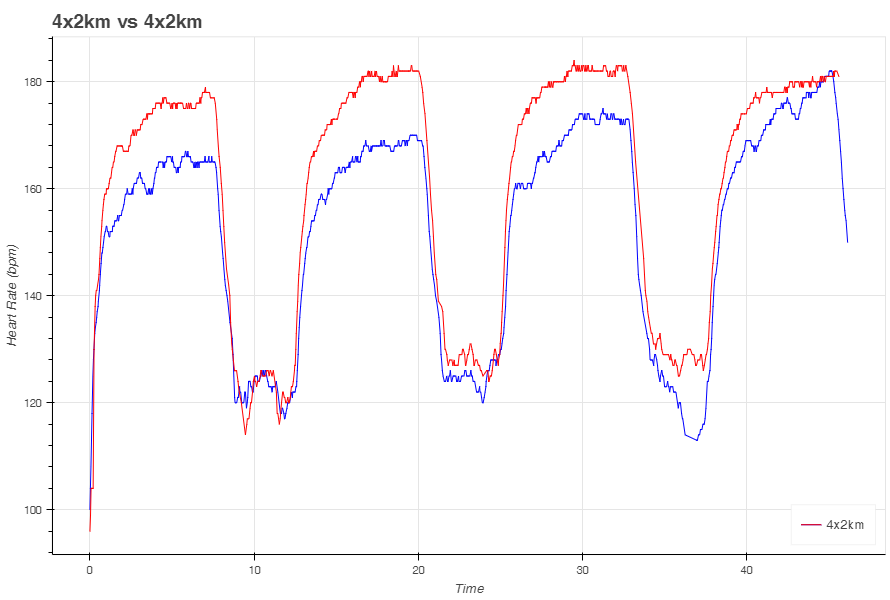
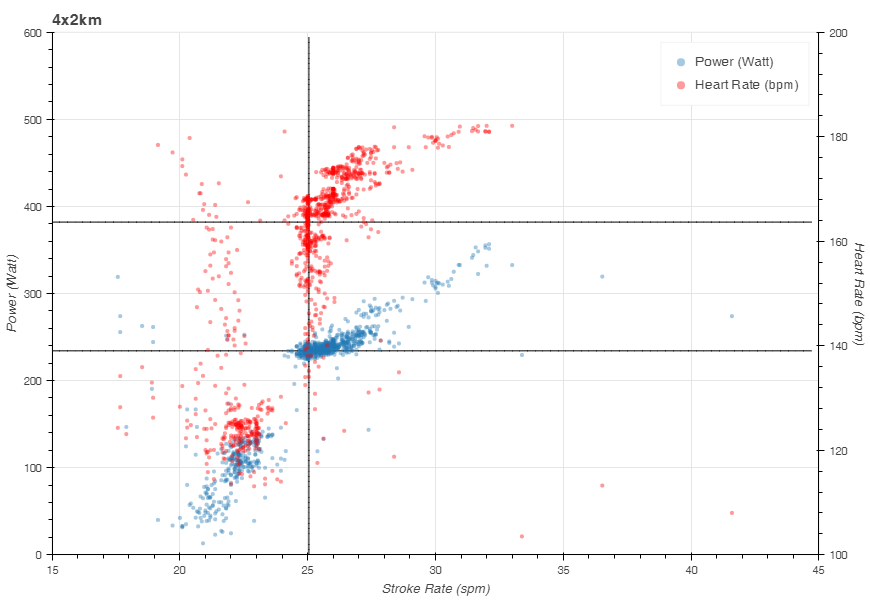
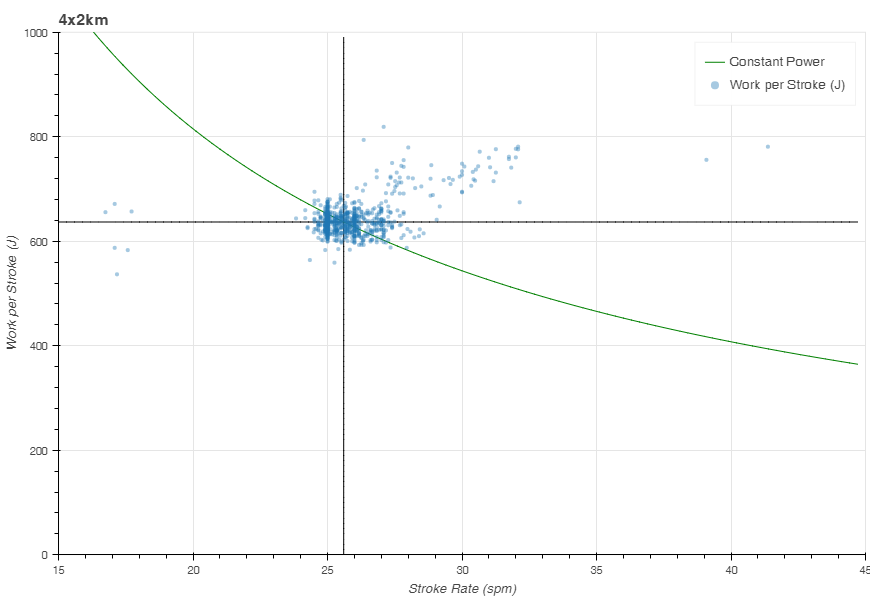
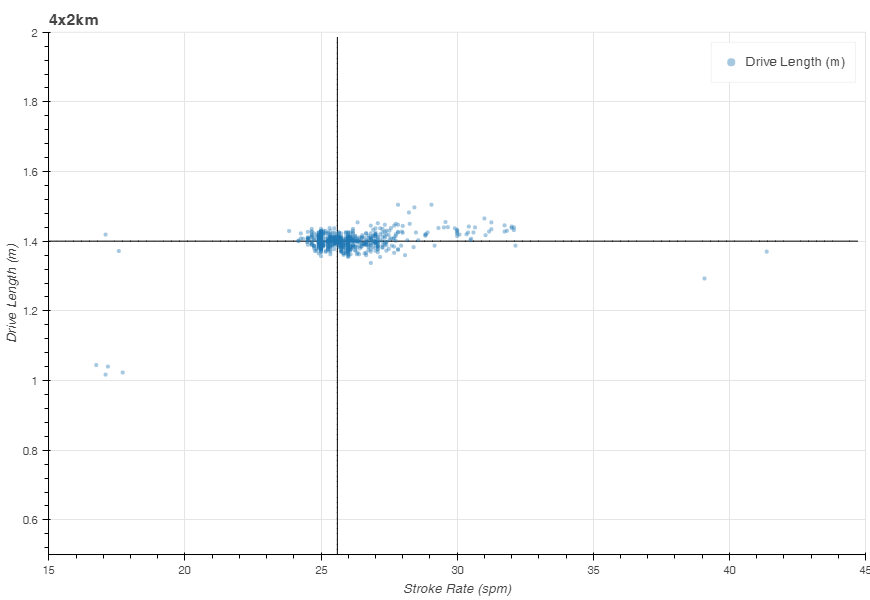
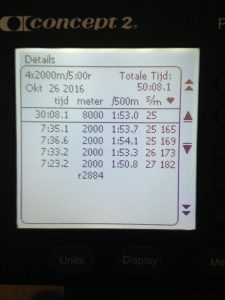

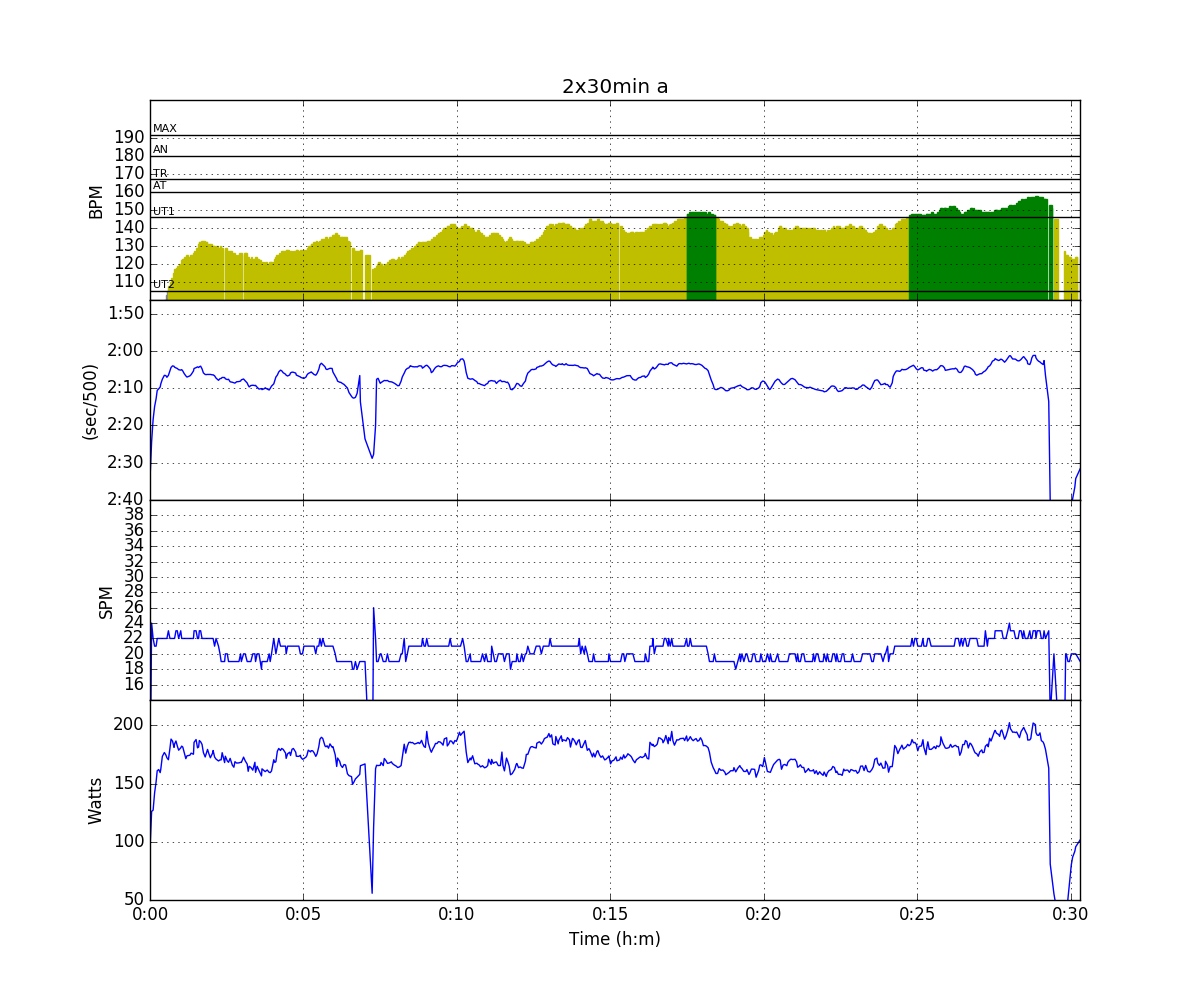
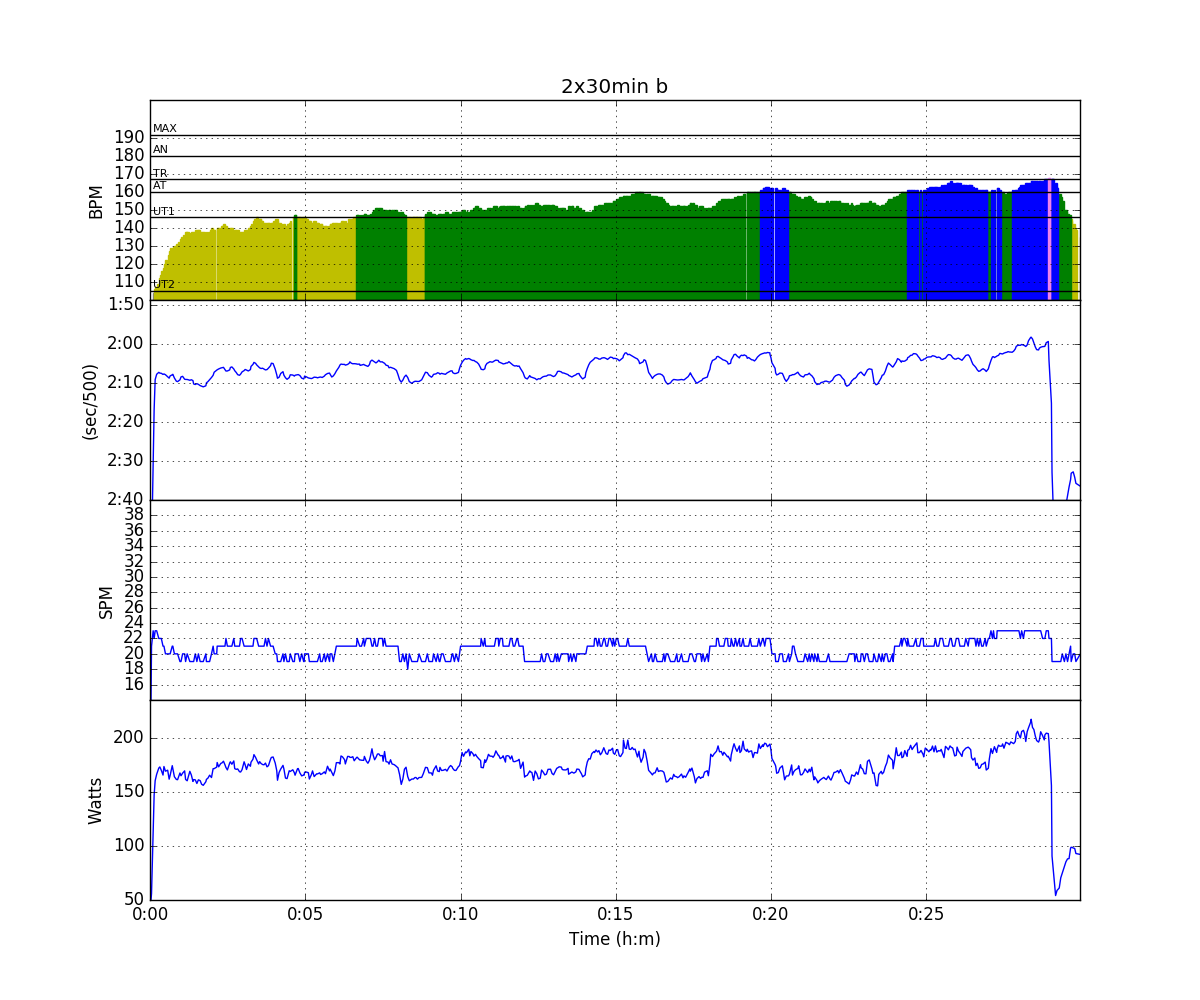
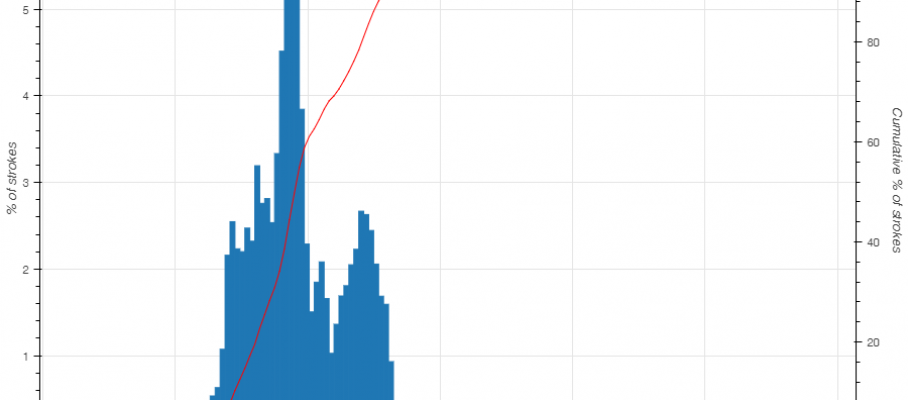
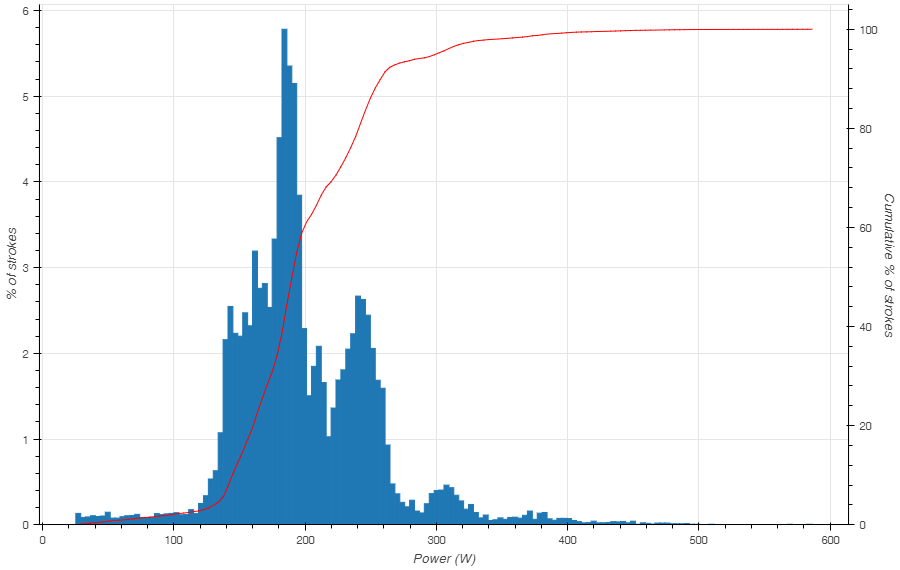
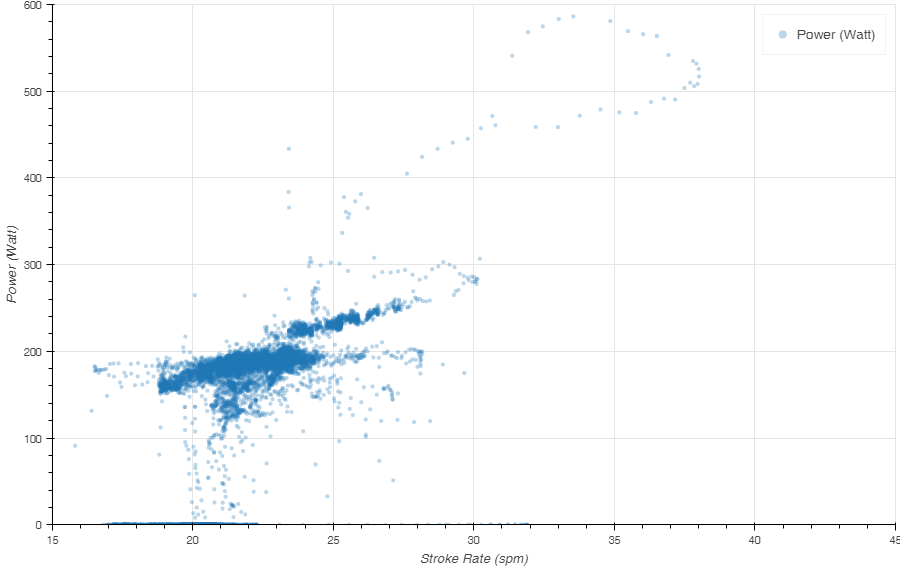
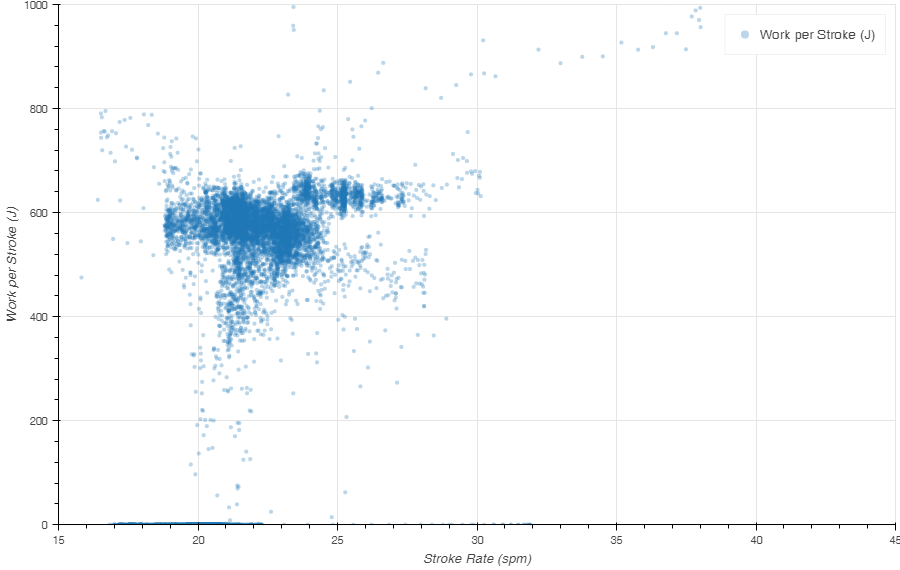
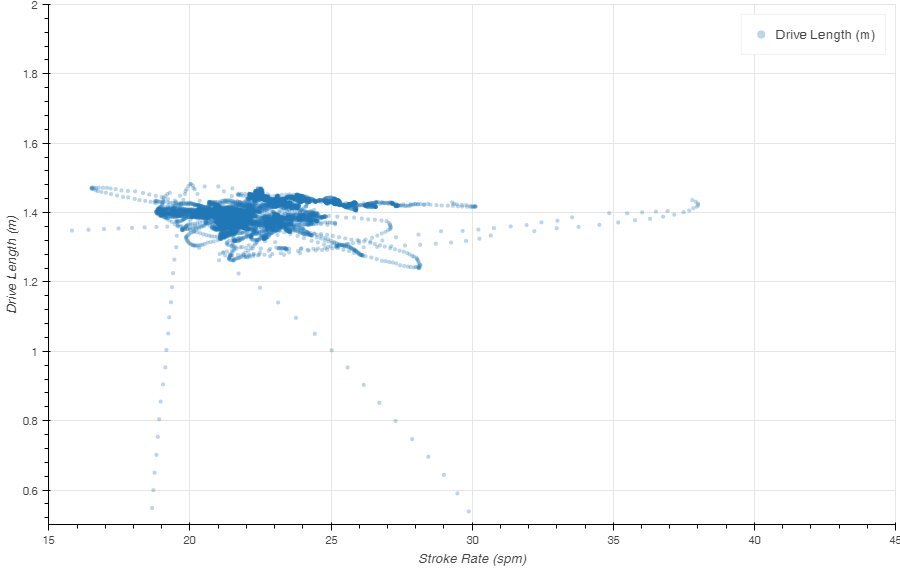
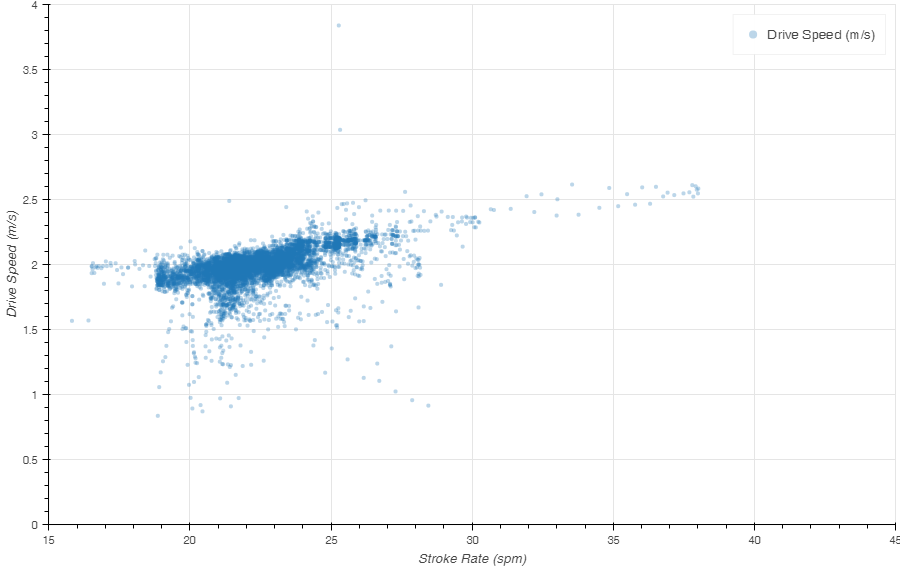
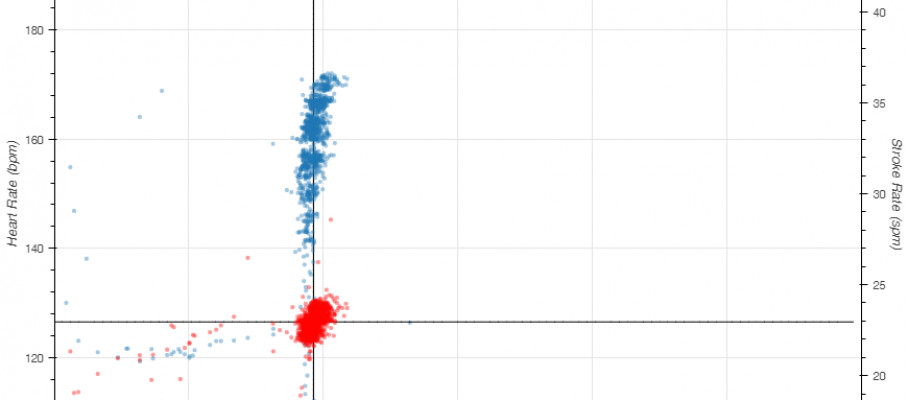


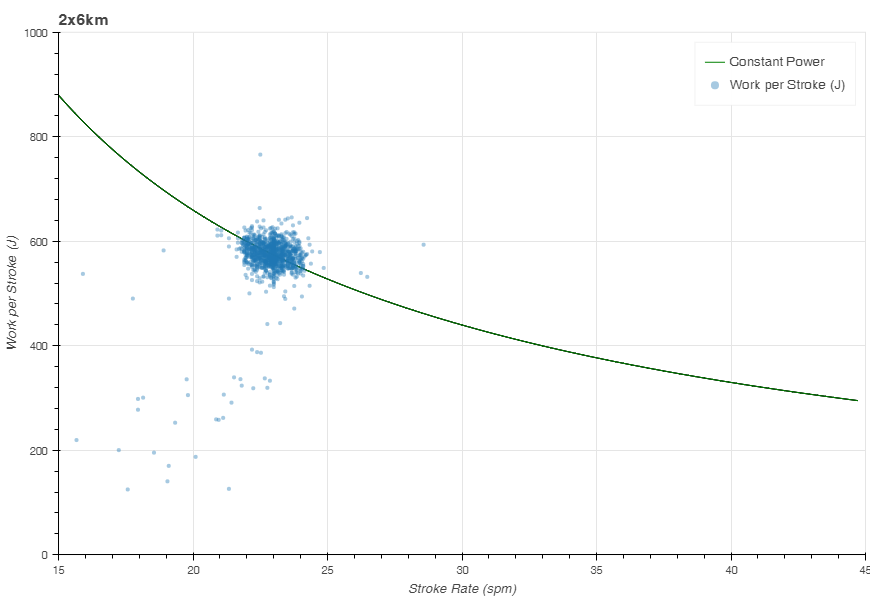
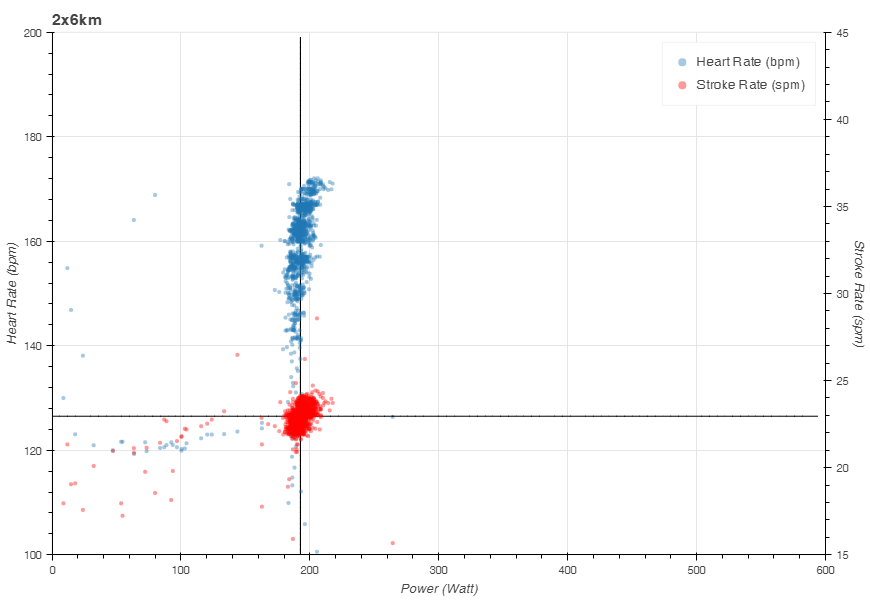
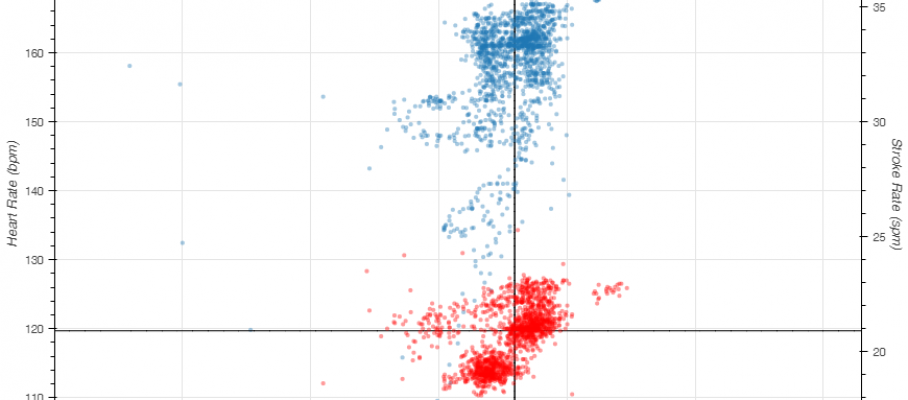

 The training plan talked about “4x20min”, but instead of that I just sat down in “Just Row” mode and started pulling 6 minute “Wolverine Plan” intervals at 170-190W. After exactly 60 minutes I stopped to take a lactate measurement: 1.2 mmol/L. And after that I continued rowing until I hit 18km.
The training plan talked about “4x20min”, but instead of that I just sat down in “Just Row” mode and started pulling 6 minute “Wolverine Plan” intervals at 170-190W. After exactly 60 minutes I stopped to take a lactate measurement: 1.2 mmol/L. And after that I continued rowing until I hit 18km.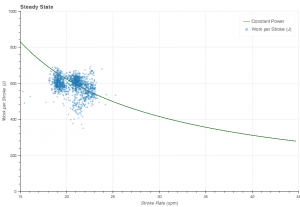
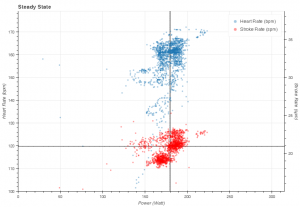
Nov 4 2016
That great feeling at Lactate=8.9 mmol/L (CTC+lactate test+nonathlon+ranking)
Today was a 4 results in one session. The training plan had a “2 speed test” scheduled. The tests consists of rowing 2x1000m at different paces. The first one at “6km pace” and the second one full out. This month’s CTC is a 1000m, and the 1k is also a ranking distance on both the C2 log book and the nonathlon competition.
I started with a nice 20 minute “Fletcher” warming up:
I have recently read a few studies about warming up and priming the Aerobic system to reduce the build-up of “oxygen debt” at the start of a race/workout. The Fletcher warming up is perfectly in line with the conclusions of those studies: It pays off to do a few bouts of hard strokes during the warming up. Also, the studies showed that the effect lasts for more than 30 minutes after the warming up, so I was confident that the warming up plus the first 1k would prepare me well for the second 1k.
Did I mention that the mental aspect of indoor rowing is huge? I normally told myself that I couldn’t row a Personal or Season’s best in that second 1k, because I would already have 1k at “6k” pace in my legs. Today I told myself that the first 1k was actually part of a very long, scientific warming up.
The first 1k was done in 3:40.9, which corresponds to 260W average, slightly lower than a month ago.
Workout Summary - media/20161104-182905-sled_2016-11-04T17-21-03ZGMT+1.strokes.csv
--|Total|-Total-|--Avg--|Avg-|-Avg-|-Max-|-Avg
--|Dist-|-Time--|-Pace--|SPM-|-HR--|-HR--|-DPS
--|01000|03:40.9|01:50.5|27.1|166.5|179.0|10.1
W-|01000|03:40.9|01:50.5|27.1|166.5|179.0|10.1
R-|00000|00:00.0|00:00.0|00.0|000.0|179.0|00.0
Workout Details
#-|SDist|-Split-|-SPace-|SPM-|AvgHR|MaxHR|DPS-
01|00100|00:21.4|01:47.0|26.4|127.5|147.0|10.6
02|00100|00:22.5|01:52.4|26.8|156.5|161.0|10.0
03|00100|00:22.4|01:52.1|27.0|164.4|165.0|09.9
04|00100|00:22.2|01:51.2|26.9|167.0|169.0|10.0
05|00100|00:22.2|01:51.0|26.7|171.5|172.0|10.1
06|00100|00:22.0|01:49.8|27.1|172.7|174.0|10.1
07|00100|00:21.9|01:49.7|27.4|174.7|176.0|10.0
08|00100|00:21.8|01:49.0|27.6|175.7|176.0|10.0
09|00100|00:21.8|01:49.1|27.7|176.7|177.0|09.9
10|00100|00:21.8|01:48.8|27.5|177.8|179.0|10.0
Let’s say I started conservatively, but things went well and I got into a nice rhythm, so eventually I dared to go below 1:50 pace.
After the first 1k, I did 15 minutes of slow paddling, with a lactate measurement at 1 minute and 3 minutes after the 1k. The measured values were 4.1 mmol/L and 3.1 mmol/L respectively.
Then the main event. CTC, ranking piece, and second part of the 2 speed test in one.
Workout Summary - media/20161104-183109-sled_2016-11-04T17-44-18ZGMT+1.strokes.csv
--|Total|-Total-|--Avg--|Avg-|-Avg-|-Max-|-Avg
--|Dist-|-Time--|-Pace--|SPM-|-HR--|-HR--|-DPS
--|01000|03:21.4|01:40.7|32.2|176.9|185.0|09.3
W-|01000|03:21.4|01:40.7|32.2|176.9|185.0|09.3
R-|00000|00:00.0|00:00.0|00.0|000.0|185.0|00.0
Workout Details
#-|SDist|-Split-|-SPace-|SPM-|AvgHR|MaxHR|DPS-
01|00100|00:19.1|01:35.3|34.3|136.9|161.0|09.2
02|00100|00:20.4|01:41.9|31.5|170.4|174.0|09.3
03|00100|00:20.4|01:42.2|31.3|176.8|178.0|09.4
04|00100|00:20.2|01:40.9|31.6|180.0|181.0|09.4
05|00100|00:20.2|01:40.8|31.5|181.8|182.0|09.5
06|00100|00:20.1|01:40.3|31.2|183.3|184.0|09.6
07|00100|00:20.2|01:40.8|31.7|184.5|185.0|09.4
08|00100|00:20.2|01:40.8|31.9|184.4|185.0|09.3
09|00100|00:19.9|01:39.3|33.3|184.8|185.0|09.1
10|00100|00:20.2|01:40.9|33.8|184.5|185.0|08.8
I did a race start and 10 hard strokes with my eyes closed.Then I settled to good hard strokes and continued counting.
First 250m went by without any problem. In fact, I reached 600m to go with ease, but then it started to feel hard. But the counting helped, and I managed to even accelerate in the second half. The trick was to watch the SPM and make sure I rated up whenever I saw the stroke rate fall below 32spm. With 150m to go it started to be really hard, but by then I was counting sets of five strokes and I even managed to keep the pace under 1:40 in the 9th 100m interval.
Happy with 3:21.4. It’s a Season’s Best. It’s just 2 seconds above my PB, and it’s a nice improvement of my nonathlon score.
The hardest part was taking the lactate measurement one minute after the 1000m. Breathing hard, shaking, sweating, and at the same time trying to go through the lactate routine is not easy. Wipe hands. Wash hand with wet towel. Dry hand. Prick a hole in a finger. Wipe off first drop of blood. Put the lactate strip in the lactate meter. Try to get the drop of blood at the open end of the lactate strip.
That last part is the hardest. The blood drop is not big. The lactate strip is small as well. I am shaking and breathing hard. Almost everything except my hand and the lactate strip is covered in sweat (which, if mixed with the blood, makes the lactate measurement invalid), and if I miss and deposit the blood drop somewhere else than on the few mm that is the opening of the lactate strip, I can start over.
But I managed even that. The first measurement was 7.5 mmol/L, then after 3 minutes of paddling I measured 8.9 mmol/L, and after 5 minutes the value was 8.1 mmol/L.
So, compared to a month ago the curve shifted to the right, and I did a much faster second 1k. I think that is progress.
In the “weird plots from rowsandall.com” department, here is today’s harvest:
This first plot show the work per stroke for both 1k efforts, using the cumulative plot, selecting a date range that covers only today’s rows, and filtering out all the strokes below 24spm. The Work per Stroke value is significantly higher than in my Steady State rows (where it is about 640 Joules).
The second plot is the peak and average drive force for both 1k rows. The average is 220/90 lbs.
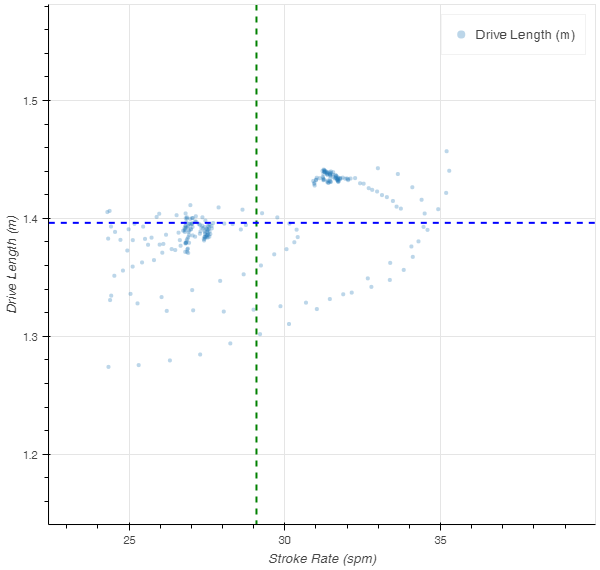
This plot show stroke length vs stroke rate for the two 1000m efforts. Interestingly, I took longer strokes at the full out effort. This again confirms my theory that this is from the increased lay back that I do when I work harder. It’s just a few cm but it looks significant.
Here is an interesting plot from the second (full out) 1k. Instead of a scatter plot, I decided to do a line plot, which connects subsequent strokes. At the bottom of the plot, I enter the chart in the first stroke at 36spm. The second and third (short) strokes go up to 44spm, and then I go through my 10 stroke sequence, each one being at a slightly lower SPM as I start to take more length. Then I spend most of the time in the 32spm/1.42m area. At the end of the 1k, I trade stroke length for stroke rate, go up to 34spm at the cost of going below 1.4m.
Finally, here is another plot from the rowsandall.com site:
It shows my best efforts over the past twelve months (the red dots) and makes two curve fits to the data. The blue line is the famous Paul’s law, and the green line is a “CP model” (something I copied from cycling data analysis). Looking at the green line, which seems to fit the data better, I can predict a target pace for next week’s 6k effort. It amounts to 1:50.9 pace, 256W, and a total time of 22:11. My PB is 22:12.0. Let’s see.
By sanderroosendaal • Uncategorized • 3 • Tags: concept2, erg, lactate, OTE, rowing, test, testing, tests